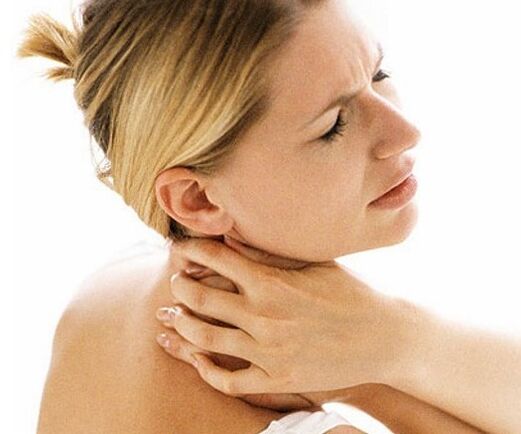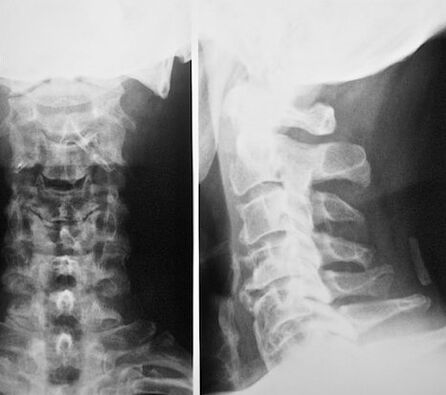Among all the diseases known by humanity are perhaps the most common diseases of the supporting motor apparatus. It is unlikely that there is a person over the age of 40 who would not experience problems with the spine, do not complain about joint pain or muscles. The cause of this phenomenon is usually a sedentary lifestyle when with age with a decrease in motor activity, salts and other harmful substances is deposited in the joints that interfere with the functionality of the bone system. It is generally accepted that diseases of the supporting and motor orata occur only in humans of mature age, but nonetheless, young people are often diagnosed in recent years with this kind of disease. It is quite difficult to treat such diseases, especially when degenerative - dystrophic changes affecting neighborly mugs, bones and nerve tissue occur in tissues. Among a number of diseases that violate the structure of the bone system, a special place is given to such a disease as cervical osteocondrosis, which is considered the most common disease of our time and is found not only in humans of mature age, but also young people under 35.

Osteochondrosis in the cervical region is a progressive disease, so early treatment and later seeking a doctor - spina, can lead to human disability. What are these insidious diseases? What are the symptoms of cervical osteocondrosis and how to deal with this disorder?
How does cervical osteochondrosis develop?
Cervical osteochondrosis is a progressive disease characterized by degenerative - dystrophic changes in the intervertebral discs served deformations change their structure, which causes a number of pronounced symptoms. At risk of the development of osteocondrosis in the cervical region are people who carry a sedentary lifestyle or whose professional activity is associated with the body in a position for a long time. With regard to the occurrence of osteocondrosis, damage to cervical spine is number two after lumbosacral osteochondrosis. The peculiarity and complexity of the disease is that the lesion in the cervical region almost always affects the nerve roots in the spinal cord nerves and intervertebral disks, as a result of large and small vessels being defeated by the blood supply to the brain.
Cervical space has a complex structure and consists of 7 vertebrae, each performing a number of functions: supports the head, turns, bends the neck and other important functions. There are intervertebral disks between the vertebrae that make the spine flexible and durable, and the intervertebral disks themselves consist of fibrous rings, of which there are pulse bags. The cervical vertebrae fit close to each other, which is why even less physical activity can cause their displacement, which in turn causes the pressure of blood vessels and nerves. In the cervical spine, the spines are responsible for the blood supply to the brain. When compressing them, the blood supply is disturbed, the brain does not receive a sufficient amount of vital substances that undoubtedly lead to its defeat and the development of a number of complications, which can lead to the patient's disability or even death.

The main causes of cervical osteocondrosis
Despite the occurrence of this disease and performance in modern medicine, the pathogenesis of osteochondrosis of cervical spine was not fully examined. It is known that the disease can develop on the basis of metabolic reduced processes in the cervical ridge, which over time leads to a change in the structure of the intervertebral discs and spine. Among other types of osteocondrosis, the cervical is the most dangerous, as during its development there is a compression of the nerve roots in the spinal cord and blood vessels, which undoubtedly leads to a violation of the blood supply to brain cells. In the pathogenesis of the disease, doctors separate several provocative factors that can lead to the development of the disease.
- A sedentary lifestyle.
- Violation of metabolic processes in the body.
- Salt deposit in the cervical region.
- Incorrect or unbalanced diet;
- Long -term interruption of the body in a position: Works on the computer and drives a car.
In addition to factors that can lead to the development of cervical osteocondrosis, experts separate people at risk of the development of this disease.
- Genetic disposal.
- Damage of cervical spine.
- Long -Term or periodic hypothermia of the body.
- Hormonal imbalance.
- Chronic diseases of the support and engine apparatus: arthritis, scoliosis, systemic lupus erythematosus.
- Overweight.
The cause of the development of cervical osteocondrosis may be other causes, but in any case the disease should be treated by its first sign.
How to recognize osteocondrosis in the cervical region and what is its sign?
Clinical signs of cervical osteocondrosis osteochondrosis of cervical spine develops slowly. The symptoms of the disease depend on the degree and the number of damaged vertebrae and squeeze the nerve endings. The most important symptom of the disease is the pain of different intensity of the spine, the neck, the lower part of the back, which is given to other organs. Only a doctor can diagnose "cervical osteochondrosis" after the examination results, as the diversity of the disease of the disease often resembles other pathologies, but everyone can suspect this disorder.
- The pain in the neck that gives the back of the head, ears, frontal part, forearm, chest, shoulder. Painful sensations of different intensities are improved with minimal loads or head gains.
- Numbness in the upper and lower extremities, burning, tingling.
- Headache, dizziness.
- A collapse.
- Darker in the eyes, "flying" in front of the eyes.
- Faint with a sharp turn of the head.
- Noise in the ears.
- Numbness in the language.
- Violation of coordination.
- Reduction of hearing, visual acuity.
- Pain in the heart.

The clinical signs of osteocondrosis in the cervical region, expressed and appear as the disease develops and progress. Doctors dealing with the treatment of this disease separate several syndromes of cervical osteocondrosis, each with their own properties and manifested depending on the damaged nervous spine.
- Rest Syndrome - develops as a result of the squeezing of the first few of nerve endings in the cervix ridge. The patient feels severe pain in the neck given in the shoulder blade, the crucifix, the shoulder and the forearm.
- Spinal arteries syndrome is characterized by a pulsating headache at the back of the head or temporal area. Irritatingly reflective syndrome -burning pain in the neck and nape, which intensifies when turning your head, sleep or coughing, gives the chest and shoulder.
- Cardial syndrome is a whole group of symptoms that are originally similar to symptoms of angina pectoris. This syndrome develops in case of damage to the spine on the membrane nerve or large breast muscles. The most important signs are considered crushing pain in the heart that does not pass after taking nitroglycerin. Such pain can last several hours, intensify when driving or deep breathing. In the patient, such symptoms cause panic as they look like a heart attack.

Symptoms of cervical osteocondrosis
Cervical osteocondrosis - Symptoms and treatment depends directly on the damaged nervous spine. The number of cervical roots is 8 and the cervical vertebrae are 7. Each cervical nerve is over the vertebra and with injuries they have their own symptoms.
If there was a defeat of the first and second cervical vertebrae (CI-II), the sensitivity of the back of the head will be disturbed, attracting pain in the parietal and occipital region.
The lesion in nerveing (C3) is extremely rare, but nonetheless the patient feels numbness in the neck, in the area where the squeezing occurred. The speed of language, sensitivity is also reduced.
The lesion of the C4 nervous spine causes pain and numbness in the collar or shoulder. Disorders of the respiratory tract, heart pain is noted.
If the back of the 5th department is disturbed, the patient will feel the pain that spreads on the shoulder, the outer surface of the shoulder, the sensitivity of the upper and lower extremities is also disturbed.
Klide the roots of C6 and C7 the most common phenomena among patients. Patients feel pain in the neck, blade, forearm, back, crucifix, the sensitivity of the hands, the fingers are disturbed.
When the nervous spine is affected, pain spreads through the neck, back, elbow and gives it to the lower extremities. Exercise of the small fingers on the arms and legs is noted, the skin's sensitivity is practically absent. The legs and hands on the hands get a bluish tint due to decreased blood circulation.
In addition to pain syndromes, a patient with cervical osteocondrosis also complains of other disorders described above in the signs of the disease: decreased vision, dizziness, fainting, etc.
Media Physical Exercise to Cervical osteocondrosis
It is necessary to perform and perform physiotherapy exercises only after hearing a doctor. In addition, the movement should discuss each execution with a specialist as the wrong location of the neck or limbs even more harm health and worsen treatment. Consider a few safe exercises that can and should be performed for patients with cervical osteocondrosis.
- In a lying position on a flat surface - spread your arms to the sides. Lift up your arms, turn your body with light movements slightly to the left, right. The left palms on your hand touch your right palm and vice versa. Do such exercises 5 - 6 times.
- In a lying position on the stomach, stretch your arms along the body. Try to relax your muscles and slowly turn your head to the left and then to the right. It is necessary to try to get the edge of the ear to touch the floor. Such an exercise can be performed standing as in the picture. Complete 8 - 10 times.

- Lying on your stomach, try to lean your chin in your palm, your neck muscles should be relaxed. Does 5 times.
- Drink your head a little and then lower it gradually. The neck muscles resist so that such exercise must be done carefully. Repeat the exercise 5-6 times.
- You have to get up exactly, fix your shoulders. Then slowly turn your head to the right and then to the left. Then 5 - 6 times.
- Speake your fingers on the back of the head, put your elbows together, put your forearm chin. Try to raise the reduced forearm as high as possible. Repeat such an exercise 5 - 6 times.
- Take your knees. With slow movements, raise your head up and freeze the body down and stretch your arms forward. Then 5 - 6 times.
Physical physical exercise is quite effective in treating cervical osteochondrosis, but all exercises must be performed regularly and correctly. Of course, the condition is not improved from the first classes, so you have to be patient.
Treatment of osteocondrosis of cervical ward with folk remedies
Traditional medicine has also shown its effectiveness in the treatment of cervical osteochondrosis, which for decades for hundreds of years has gathered a large number of recipes in its arsenal that will help reduce the symptoms of the disease. Treatment of osteocondrosis with folk remedies is to use vegetable and animal products for external or internal use.
Recipe 1. Honey from cervical osteocondrosis. You need 1 - 2 teaspoons of natural sibling, 2 tablets mummy. Honey and mummy need to be heated, put on a warm scarf and attached to the neck for the night. Honey has a pronounced anti -inflammatory, biostimulating property so that it can perfectly supplement the treatment of this disorder.
Recipe 2. Celery from osteochondrosis. 4 - 5 grams of celery should be poured with 1 liter of boiling water, insisting 2 - 4 hours, loaded and taking 1 large spoon 3 times a day.

Recipe 3. A decoction of chamomile and olive oil. You need 30 grams of chamomile flowers, 0, 5 l Olive Unpeeled Oil. Kamile flowers should be poured into the oil, lay on little fire, boil up and allow to cool. You have to insist on a decoction for 2 days, and then sille it through the full and rub the sick areas with the resulting oil. Along with chamomile, other herbs can be used: Celandine, Calendula, St. John's Wort. If no olive oil is available, you can take sunflower.
There are other means of traditional medicine that help relieve symptoms of cervical osteochondrosis. However, it is important to remember that such treatment is only effective at the beginning of the development of the disease and can only be used in complex treatment with traditional methods.
Prevention
Prevention of osteocondrosis in the neck is an active lifestyle. In cases where there is a place for the development of this disease, it is necessary to regularly visit a doctor - orthopedic. There is no less important place possessed by food that must be useful, rich in vitamins, minerals and other beneficial substances. Prevention or correction of excess weight as well as regular physical exercises reduce the risk of developing cervical osteocondrosis several times.

















































